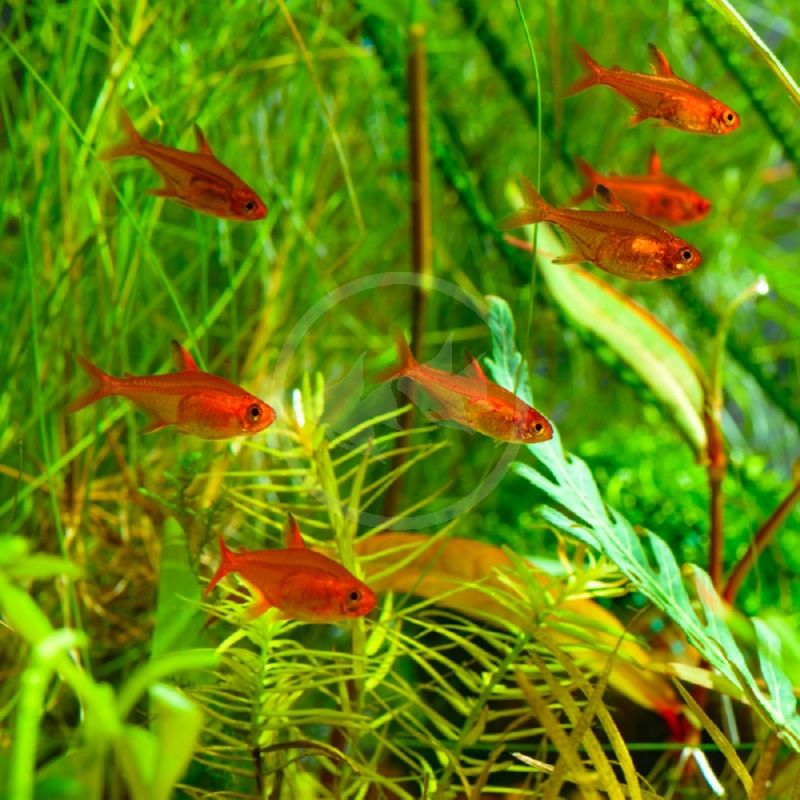Ember Tetra (Hyphessobrycon amandae)
Ember Tetra (Hyphessobrycon amandae)
The Ember Tetra (Hyphessobrycon amandae) is a small, vibrant freshwater fish native to the waterways of Brazil. Known for its stunning bright orange-red coloration, it’s a popular choice for aquariums due to its peaceful nature and attractive appearance.
1. Tank Size
-
Due to their small size (usually only 0.8-1 inch or 2-3 cm), Ember Tetras can thrive in smaller tanks. However, they should be kept in schools of at least 6-8 individuals.
-
A tank of at least 10 gallons (38 liters) is recommended for a small group of Ember Tetras.
2. Water Conditions
-
Temperature: Ember Tetras prefer warm water and do best in a range of 73°F to 84°F (23°C to 29°C).
-
pH: These fish prefer slightly acidic to neutral water, with a pH range of 6.0 to 7.5.
-
Hardness: Soft water is ideal for Ember Tetras, with a hardness range of 2-15 dGH.
-
Water Quality: Good water quality is essential for the health of Ember Tetras. Regular water changes (about 25% per week) are necessary to maintain stable conditions.
3. Diet
-
Ember Tetras are omnivores and will eat a wide variety of foods:
-
High-quality flakes or pellets designed for small fish.
-
Live or frozen foods, like brine shrimp, daphnia, bloodworms, and micro worms.
-
Vegetable matter, such as blanched spinach, spirulina, or algae-based food.
-
-
Feed them small amounts 2-3 times a day. Ember Tetras have tiny mouths, so ensure the food is appropriately sized.
4. Tank Setup
-
Substrate: Use a fine gravel or sand substrate, as it is easy to clean and won’t harm the fish.
-
Aquascaping: These fish enjoy a well-planted tank. Provide plenty of live plants like Java Moss, Cryptocoryne, and Anubias, which also provide hiding spots.
-
Lighting: Ember Tetras thrive under moderate lighting, and having plants in the tank helps to create shaded areas for them to feel secure.
-
Water Movement: A gentle filter with low to moderate water flow is ideal, as these fish are not fond of strong currents.
5. Tankmates
-
Ember Tetras are peaceful and non-aggressive, making them great companions for other small, calm fish.
-
Suitable tankmates include:
-
Other small tetras, such as Neon Tetras or Black Phantom Tetras.
-
Rasboras, Corydoras catfish, and shrimp (like Cherry Shrimp).
-
-
Avoid keeping them with large or aggressive fish that may outcompete them for food or harass them.
-
Keeping them in schools is important as they are schooling fish, and being in a group reduces their stress.
6. Breeding
-
Breeding Ember Tetras in captivity is possible but requires specific conditions:
-
Set up a separate breeding tank with soft, slightly acidic water and plenty of fine-leaved plants like Java Moss or Marimo Moss Balls.
-
Spawning: Female Ember Tetras will scatter their eggs among the plants. After spawning, the parents should be removed to prevent them from eating the eggs.
-
Incubation: The eggs will hatch in 24-48 hours, and the fry can be fed infusoria or liquid fry food until they are large enough to eat powdered food or tiny live foods.
-
7. Health
-
Ember Tetras are generally hardy but can be susceptible to common freshwater diseases like Ich, fin rot, and velvet disease, especially if water quality is poor.
-
Monitor water parameters regularly to prevent fluctuations that could stress the fish and lead to illness.
-
Keep an eye on their diet and ensure they are not overfed, as this can lead to health issues like obesity or poor water quality.
-
If you notice symptoms like lack of appetite, faded colors, or abnormal behavior, it’s essential to address water quality or isolate the affected fish for treatment.
Interesting Fact:
Ember Tetras get their name from their vibrant orange-red coloration, which resembles the glow of embers in a fire. This bright color is especially striking when they are kept in dark or dimly-lit tanks, making them one of the most visually appealing small fish for aquariums. In the wild, this coloration helps them blend in with their natural environment, as they are found in slower-moving waters of the Tocantins River in Brazil, where the water is often tannin-stained and slightly acidic.

